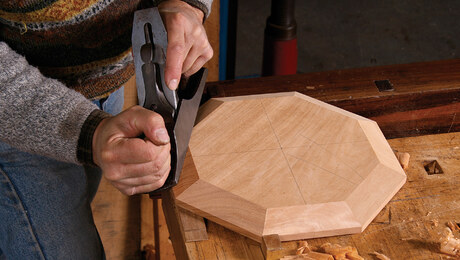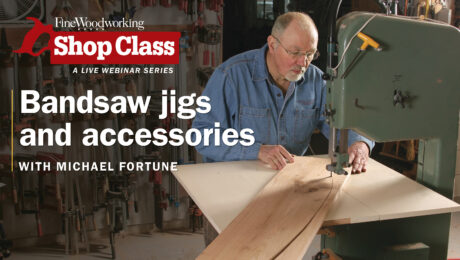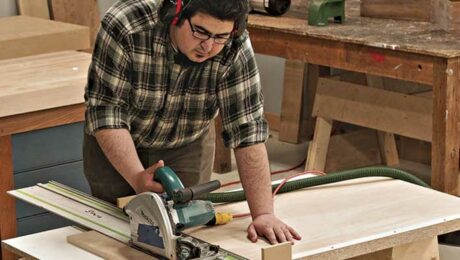STL280: Bench top jointers and ditching the table saw
Vic and Ben discuss life without a table saw, how much room a bandsaw takes up, bench top jointers, and how to be a good Instagram community member. |
Make a faceted octagon with hand toolsMichael Cullen demonstrates one of his favorite hand-tool exercises— making a perfect octagon—which tests a woodworker’s skill from material selection and careful layout to tool preparation, blade sharpening, and sawing and handplaning skills. |
Question 1:
From Mark:
I’m glad to hear Vic is going to be a permanent part of the show! I’m also very interested in the fact that he runs a bandsaw-centered shop with no table saw. I also don’t have a table saw and don’t plan on getting one. (I have a track saw with the Festool MFT table and a nice router table.) Unfortunately, I don’t have a bandsaw yet either. You can imagine I really need one since I have no way to rip narrower boards accurately and efficiently. I would also resaw often with this saw. (I’ve been filling this gap with hand tools but I’d like to be more efficient as I have a 2-year-old son and don’t get a ton of shop time.) I don’t anticipate much curve cutting though it may come up from time to time.
Since I have a small garage shop where space is very limited I’ve been planning to buy a “high-end” 14″ saw. The options I’m considering right now are the Laguna 14bx and the Rikon 10-353. (I’d love to get something like the 16″ South Bend 1080, but I don’t think I can afford the extra 8″ of depth when it’s backed up against the wall.)
I have 3 major questions:
1. Which saw should I get?
2. I was planning on using my shop-vac with a mini cyclone for dust collection since I don’t have the space for a stand-alone collector. Is this a deal-breaker for this type of saw?
3. How much standing space should I have on the infeed side of the saw? Obviously, I need enough room to open the doors and change the blade. Can I get away with just enough room for maintenance and stand in front of the machine when I’m using it? I’d like to back the saw up to a wall and have a row of cabinets on either side of it. I’ve never seen anyone with an outfeed table on a band saw like a table saw typically has, but it seems like it would work well.
 |
Bandsaw Jigs and AccessoriesWatch this webinar with Michael Fortune for a fascinating look into how he gets the most from his bandsaws. |
Additionally, I’d like to hear more about the realities of working in a shop without a table saw. (I think this could even be a whole episode…) What tasks are more difficult? Cross-cutting small pieces without a sled? (Can you use a cross-cut sled on a bandsaw?) Do you cut dadoes across long boards with a miter gauge on the router table or a handheld router? When do you use a slot cutter bit instead of a straight bit? What are other must-have router bits/tools/techniques? What do you think about the overall safety of a shop without a table saw? Are there operations that you think would be safer with the table saw?
 |
How To Make a Tracksaw Crosscut TableBen Strano shows how to build a table that will make the track saw your go-to tool for crosscutting panels that are too big for your table saw. |
I know this is a lot of questions, so don’t worry if you can’t answer all of them. Thanks for running the show, it’s entertaining and informative! It’s at the top of my podcast list. It also helped push me over the edge to get the FWW unlimited membership.
Question 2 (and 3):
From Zachary:
I was in a national woodworking store recently and noticed a large woodworking tool company (Jet) was offering a 10” Jointer / Planer combo machine for around $900 (Model 707410). I already have a planer (Dewalt) but the price for the combo machine has me tempted. Checking prices, the same company’s 8” dedicated jointer comes in at more than twice the cost ( $2100 – Model 718218K).
I’m curious about your thoughts on using this as a dedicated Jointer. I feel like it might be a good value, but I’m not sure what I’m missing. I do want to get a jointer, but am not in any rush. What limitations would the combo machine have that a dedicated jointer would not?
Related:
From Jesse:
What do you think of the 8” bench top jointers like the grizzly G0834 or the comparable rikon models? In the past episodes it’s often said a 6” jointer isn’t worth buying because you will outgrow it quickly, is the same true of the 8” benchtop models. The price of the bench top models makes them very attractive but I wonder if the smaller motors, lighter weight, shorter tables, etc make it not worth it. It’s obviously cheaper than a larger floor-standing model but if I outgrow it and have to buy a larger model in the future it becomes more expensive. I am a hobbyist woodworker and have a few dining tables and bed frames in my future and I understand the length or size of boards might be a bit much for the benchtop model but is it something I could work with? If it’s not worth it, I would have to wait a while to buy the floor model but that won’t stop those projects I will just build them with the tools I have at the moment. So my question I guess is whether they worth it and can you work around the limitations much like you would if you don’t have the tool at all or would you outgrow them and it’s best to just wait till I can wait to buy the larger floor model?
Every two weeks, a team of Fine Woodworking staffers answers questions from readers on Shop Talk Live, Fine Woodworking‘s biweekly podcast. Send your woodworking questions to [email protected] for consideration in the regular broadcast! Our continued existence relies upon listener support. So if you enjoy the show, be sure to leave us a five-star rating and maybe even a nice comment on our iTunes page.






















Comments
Really liked the bandsaw discussion, thanks. I was curious about your take on one part of the first question that I don’t think you really got in to — is standing on the side of the bandsaw (opposite the spine) a workable position? In other words, can you set a bandsaw up like a miter saw and have infeed/outfeed extensions flush with the table (caveat about blade change clearance that the original question mentions) and do all the work from the side by sliding the work from left to right?
For some operations that would work. I wouldn't like it at all for following a pencil line for curves. And some bigger curves could hit the wall. Resawing would be difficult, too, I would think.
I like it by the wall, and rolling out when necessary.
At the risk of tool shaming Ben and being blocked from Fine Woodworking, I don't understand how you guys can spend so much time on Instagram and still get some woodworking done.
It's literally part of our jobs.
Thanks for taking the time to answer my questions about bandsaws. I guess I should have also mentioned that I do have the Festool OF 1400 router and the rail guide accessory for it. Not tool shaming anyone but it’s a great setup, at least for me.
That's not tool shaming! Tool shaming is when you see someone with a different router and without prompting, tell them that they should get the router you have.
Is kind of funny hearing you complain about mansplaining, when you had the mansplaining king just a week ago on the podcast 😂
Log in or create an account to post a comment.
Sign up Log in